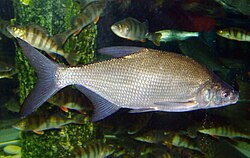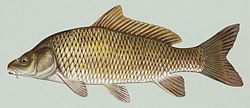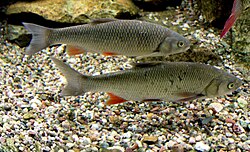
Coarse fishing (Irish : garbhiascaireacht, Welsh : pysgota bras) is a phrase commonly used in Great Britain and Ireland. [1] [2] It refers to the angling for rough fish, which are fish species considered undesirable as food or game fish. Freshwater game fish are all salmonids, particularly salmon, trout and char. Generally, coarse fish are freshwater fish that are not salmonids, though there is often disagreement over whether grayling should be classified as a game fish or a coarse fish. [3]
Contents
- Bait
- Game fish
- General
- Coarse fish
- Licences and fees
- Tackle and technique
- Target species
- Carp
- Perch
- Pike
- Catfish
- Less targeted species
- See also
- Notes
- References
- Further reading
- External links
Fly fishing is the technique usually used for freshwater game fishing, while other angling techniques are usually used for coarse fishing. [4] The sport of coarse fishing and its techniques are particularly popular in the United Kingdom and mainland Europe, as well as in some former British Commonwealth countries and among British expatriates.
The distinction between coarse fish and game fish, terms that developed in the United Kingdom in the early 19th century, has no taxonomic basis [5] Before that time, recreational fishing was a sport of the gentry, who angled for salmon and trout and called them "game fish". There was a view that other fish did not make as good eating, and they were disdained as coarse fish. [6] [7] Coarse fish have scales that are generally larger than the scales of game fish, [5] and tend to inhabit warmer and stiller waters.




















